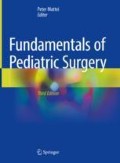Abstract
Neonatal jaundice is a common problem associated with the transition from fetal to neonatal life. It is caused by the accumulation of bilirubin in the skin. Bilirubin is created from biliverdin, which is the breakdown product of heme proteins. In the older child and adult, bilirubin is conjugated in the liver, excreted into the intestine, and eliminated from the body. Over 50% of newborns exhibit jaundice in the first few days of life and, in most cases, this is physiologic and due to a physiologic delay in bilirubin conjugation. In certain clinical circumstances, pathological etiologies of hyperbilirubinemia should be entertained. The mainstay of treatment for hyperbilirubinemia is phototherapy, which converts bilirubin into a water-soluble and easily excretable form. Intravenous γ-globulin (IVIG) is used as adjunctive therapy for isoimmune hemolytic disease. In severe cases, a double-volume exchange transfusion is indicated. Gestational age and postnatal age-specific guidelines guide therapy. The reason to treat jaundice is the association with neurological sequelae when bilirubin levels rise high enough to overwhelm protein binding, cross the blood–brain barrier, and cause neuronal injury.
Access this chapter
Tax calculation will be finalised at checkout
Purchases are for personal use only
Further Reading
American Academy of Pediatrics, Subcommittee on Hyperbilirubinemia. Management of hyperbilirubinemia in the newborn infant 35 or more weeks of gestation. Pediatrics. 2004;114(1):297–316.
Bhutani VK, Johnson L, Sivieri EM. Predictive ability of a predischarge hour-specific serum bilirubin for subsequent significant hyperbilirubinemia in healthy term and near-term neonates. Pediatrics. 1999;103:6–14.
Dennery PA, Seidman DS, Stevenson DK. Neonatal hyperbilirubinemia. N Engl J Med. 2001;344(8):581–90.
Johnson LH, Bhutani VK, Brown AK. System-based approach to management of neonatal jaundice and prevention of kernicterus. J Pediatr. 2002;140:396–403.
Kuzniewicz MW, Park J, Niki H, et al. Predicting the need for phototherapy after discharge. Pediatrics. 2021;147(5):e2020019778.
Maisels MJ, McDonagh AF. Phototherapy for neonatal jaundice. N Engl J Med. 2008;358(9):920–8.
Maisels MJ, Bhutani VK, Bogen D, et al. Hyperbilirubinemia in the newborn infant ≥35 Weeks’ gestation: an update with clarifications. Pediatrics. 2009;124(4):1193–8.
Maisels MJ, Watchko JF, Bhutani VK, Stevenson DK. An approach to the management of hyperbilirubinemia in the preterm infant less than 35 weeks of gestation. J Perinatology. 2012;32:660–4.
Morris BH, Oh W, Tyson JE, Stevenson D, Phelps DL, O’Shea TM, et al. Aggressive vs. conservative phototherapy for infants with extremely low birth weight. N Engl J Med. 2008;359:1885–96.
Moyer V, Freese DK, Whitington PF, et al. Guideline for the evaluation of cholestatic jaundice in infants: recommendations of the North American Society for Pediatric Gastroenterology, Hepatology and Nutrition. J Pediatr Gastroenterol Nutr. 2004;39(2):115–28.
Watchko J, Claassen D. Kernicterus in premature infants: current prevalence and relationship to NICHD phototherapy study exchange criteria. Pediatrics. 1994;93(6 Pt 1):996–9.
Watchko JF, Oski FA. Kernicterus in preterm newborns: past, present, and future. Pediatrics. 1992;90:707–15.
Wong RJ, Stevenson DK, Ahlfors CE, Vreman HJ. Neonatal jaundice: bilirubin physiology and clinical chemistry. Neoreviews. 2007;8(2):e58–67.
Author information
Authors and Affiliations
Corresponding author
Editor information
Editors and Affiliations
Rights and permissions
Copyright information
© 2022 The Author(s), under exclusive license to Springer Nature Switzerland AG
About this chapter
Cite this chapter
Wright, C.J., Posencheg, M.A. (2022). Neonatal Hyperbilirubinemia. In: Mattei, P. (eds) Fundamentals of Pediatric Surgery. Springer, Cham. https://doi.org/10.1007/978-3-031-07524-7_87
Download citation
DOI: https://doi.org/10.1007/978-3-031-07524-7_87
Published:
Publisher Name: Springer, Cham
Print ISBN: 978-3-031-07523-0
Online ISBN: 978-3-031-07524-7
eBook Packages: MedicineMedicine (R0)

